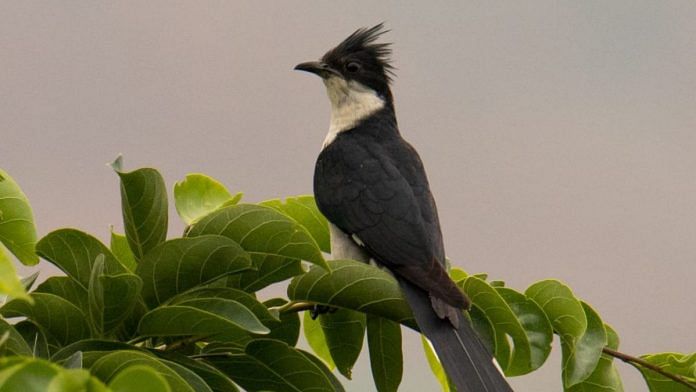Delhi: Digvijay Singh Rathore is on the road recording bird sightings. So far this year, he’s been to Gujarat, Kashmir, West Bengal, Assam, Arunachal Pradesh, Himachal Pradesh, Odisha and Assam, among other states, and has observed 944 species of birds. The 54-year-old birder’s passion started as a hobby at a boarding school in Rajasthan’s Mount Abu. Over the years, he recorded his sightings on online databases, ensuring that his valuable findings did not disappear into the black hole of data.
A lucky day of sightings for an enthusiastic bird-watcher can contribute greatly to better research and understanding of regional changes. What scientists sometimes aren’t able to do, nature lovers can.
Crowdsourced bird data is akin to jagged pieces of a puzzle that researchers use and put together to see how an ecosystem evolves.
Recently, a team at the Indian Institute of Technology (IIT)-Jodhpur conducted a study to show how crowdsourced data from the citizen-science project eBird helped them document the Thar desert ecoregion. They discovered that it is far more complicated and diverse than originally thought.
The eBird database had recorded 492 species of birds through 50,000 checklists of 4,000 birders—all in the Thar desert region alone. From the presence of birds, flight patterns, and sightings recorded by birders like Digvjiay, they found that the Thar desert region is composed of four distinct ecoregions—Eastern Thar (ET), Western Thar (WT), Transitional Zone (TZ) and Cultivated Zone (CZ). It is not a single ecoregion as classified by the World Wildlife Fund (WWF).
“This study, for the first time, proposes crowdsourced bird data as an important biota-based tool to understand established ecoregions in an ecosystem, anthropogenic effects of agri-farmlands and the relation between geographic regions and biota [living organisms],” wrote the IIT-Jodhpur team. Their findings were published in the Global Ecology and Conservation journal on 28 June 2023.
Also read: Everything you need to know about Nature Conservation Day
How citizen birders contribute
On online platforms, citizens record where they see a particular bird, even sharing audio clips of its cheeps, trills and birdsongs. The platform, eBird—developed by Cornell Lab of Ornithology and the US National Audubon Society—also has a dedicated portal for India, which is managed by Bird Count India. Before eBird was set up in 2015, enthusiasts and researchers used to coordinate with fellow birders via email or WhatsApp groups.
Earlier this year, bird science enthusiasts in India uploaded more than 45,000 ‘checklists’ – lists of birds they sighted in a span of 15 minutes – as part of the Great Backyard Bird Count (GBBC). India saw the highest number of participants among the 190 countries that took part in the global bird count this year, and at least 1,067 bird species were recorded on eBird.
State governments, too, are roping bird-watchers for counting exercises. In November last year, around 70 bird-watchers across 11 states carried out a bird documentation exercise over three days in Chhattisgarh’s Kangar Valley. Together, they have documented over 200 bird species. The survey was organised by the Forest Department of Kanger Valley National Park and birders from Chhattisgarh in collaboration with Birds & Wildlife of Chhattisgarh and Bird Count India. They, too, reported their findings on eBird.
It was citizens who spotted the rare black-throated thrush and the brown hawk owl for the first time in Delhi in 2016.
“The black-throated thrush was seen a few years ago in huge numbers, something we call an eruption. But now it is barely visible in Delhi,” says Bharati Chaturvedi, environmentalist and founder of the non-profit organisation Chintan.
Also read: Study discovers human impact on wildlife even in protected areas
Driven by nature, passion for science
Rathore has declared 2023 as the ‘big year’ to identify as many species of birds as possible.
“I feel things are easier for me because of the support one gets from citizen science platforms like eBird and social media platforms such as Instagram and Facebook,” Rathore told ThePrint.
The motivations of Rathore and other birders are partly personal and partly collaborative, arising from their enthusiasm for nature and the greater good of science.
“I primarily do it for my personal record and enjoyment. But this documentation also aids citizen science,” says Nikhil Devasar, founder of the Delhi Bird Foundation. His eBird account shows that he observed 41 species of birds during his hour-and-a-half excursion at Bhondsi Nature Park in Haryana on 9 July.
And on the face of it, these reports can sound very personal.
“It was a cool day; there was a strong breeze. I saw a boat on the Yamuna; no other birders were present there. The boats might have been disturbing some of the birds. The sand banks had become farms, so we could not see the Sand lark bird around anymore,” says Chaturvedi, recounting examples of how bird-watchers document findings online.
But these ramblings and reflections can give a broader picture of what happened to an ecosystem or a region.
(Edited by Zoya Bhatti)



